
A novel option for preoperative endoscopic marking with India ink in totally laparoscopic distal gastrectomy for gastric cancer: A useful technique considering the morphological characteristics of the stomach
- Authors:
- Takaya Tokuhara
- Eiji Nakata
- Toshiyuki Tenjo
- Isao Kawai
- Syunpei Satoi
- Keisuke Inoue
- Mariko Araki
- Hirofumi Ueda
- Chihiro Higashi
View Affiliations
Affiliations: Department of Surgery, Otori Stomach and Intestines Hospital, Sakai, Osaka 593‑8311, Japan
- Published online on: March 9, 2017 https://doi.org/10.3892/mco.2017.1191
-
Pages:
483-486
-
Copyright: © Tokuhara
et al. This is an open access article distributed under the
terms of Creative
Commons Attribution License.
Metrics: Total
Views: 0 (Spandidos Publications: | PMC Statistics: )
Metrics: Total PDF Downloads: 0 (Spandidos Publications: | PMC Statistics: )
This article is mentioned in:
Abstract
In totally laparoscopic distal gastrectomy (TLDG) for gastric cancer, accurately determining the proximal resection line may be difficult. This is because identifying the lesion intracorporeally is impossible, due to the lack of tactile sense, and, in addition, unlike the intestine, the most proximal site of the lesion is often different from the main site due to the distorted shape of the stomach. The aim of this study was to introduce a novel method of preoperative endoscopic marking with India ink, taking into consideration the morphological characteristics of the stomach. Between July, 2013 and April, 2016, 20 patients who underwent TLDG were enrolled in this study. Within the 3 days preceding the operation, after identifying the most proximal site of the lesion on the overlooking image of an endoscope, India ink was injected into the spot on the oral side of this site. The stomach was transected along the proximal border of the marked area. In all cases, the marked sites were localized and clearly identified during the operation, and the proximal resection margins were found to be negative on postoperative pathological examination. The mean length of the proximal margin was 46.0±14.0 mm. In conclusion, this preoperative endoscopic marking method may be useful in TLDG for gastric cancer.
View Figures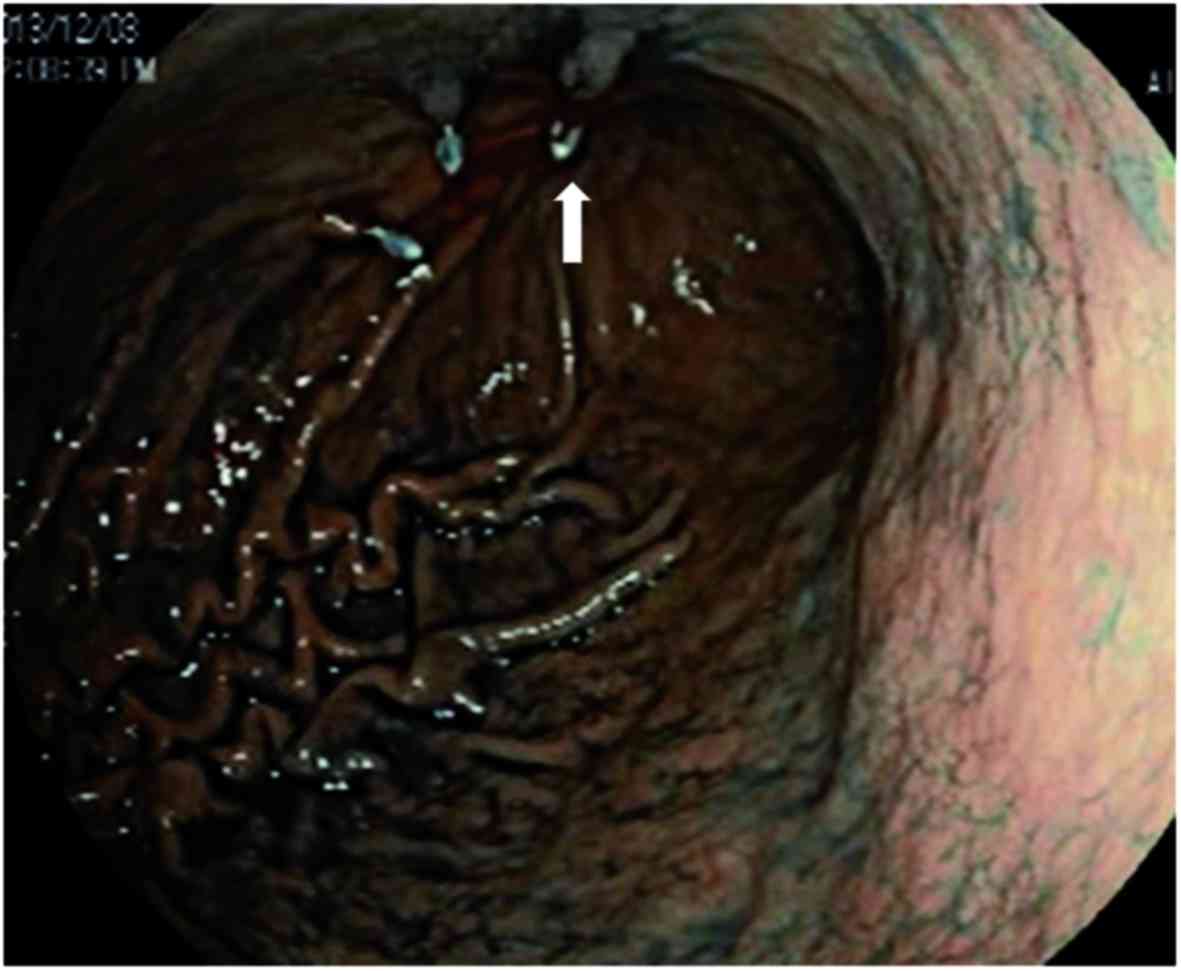 |
Figure 1
|
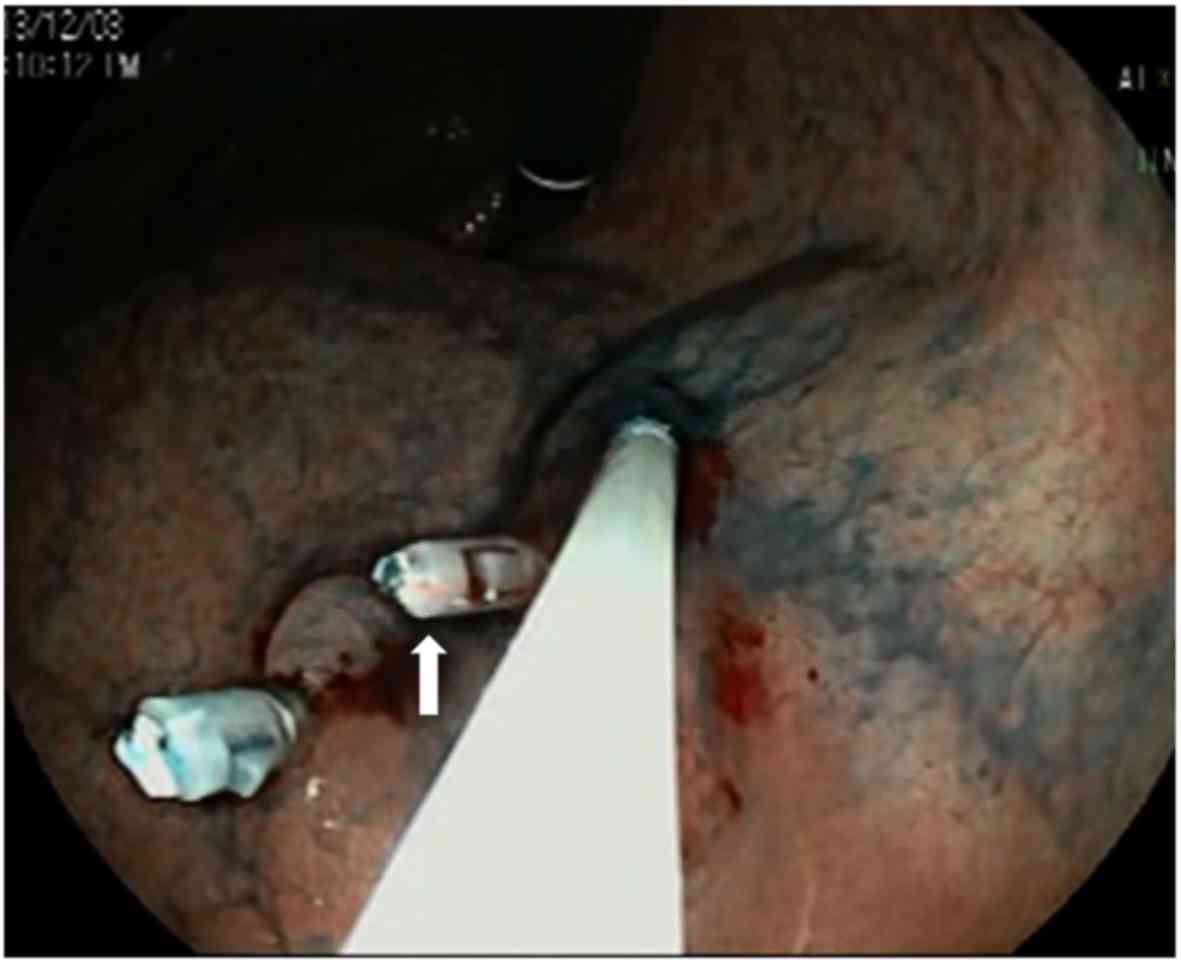 |
Figure 2
|
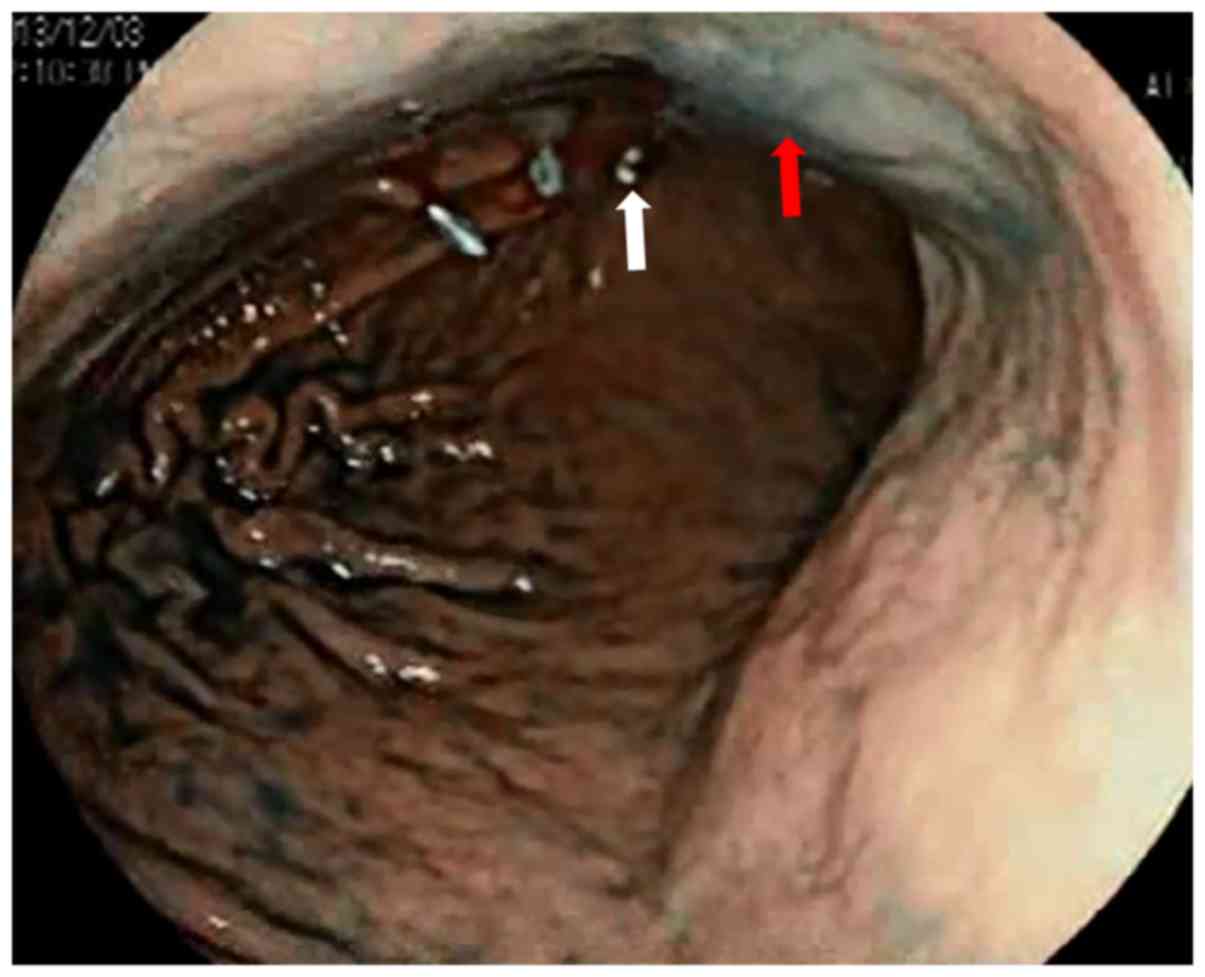 |
Figure 3
|
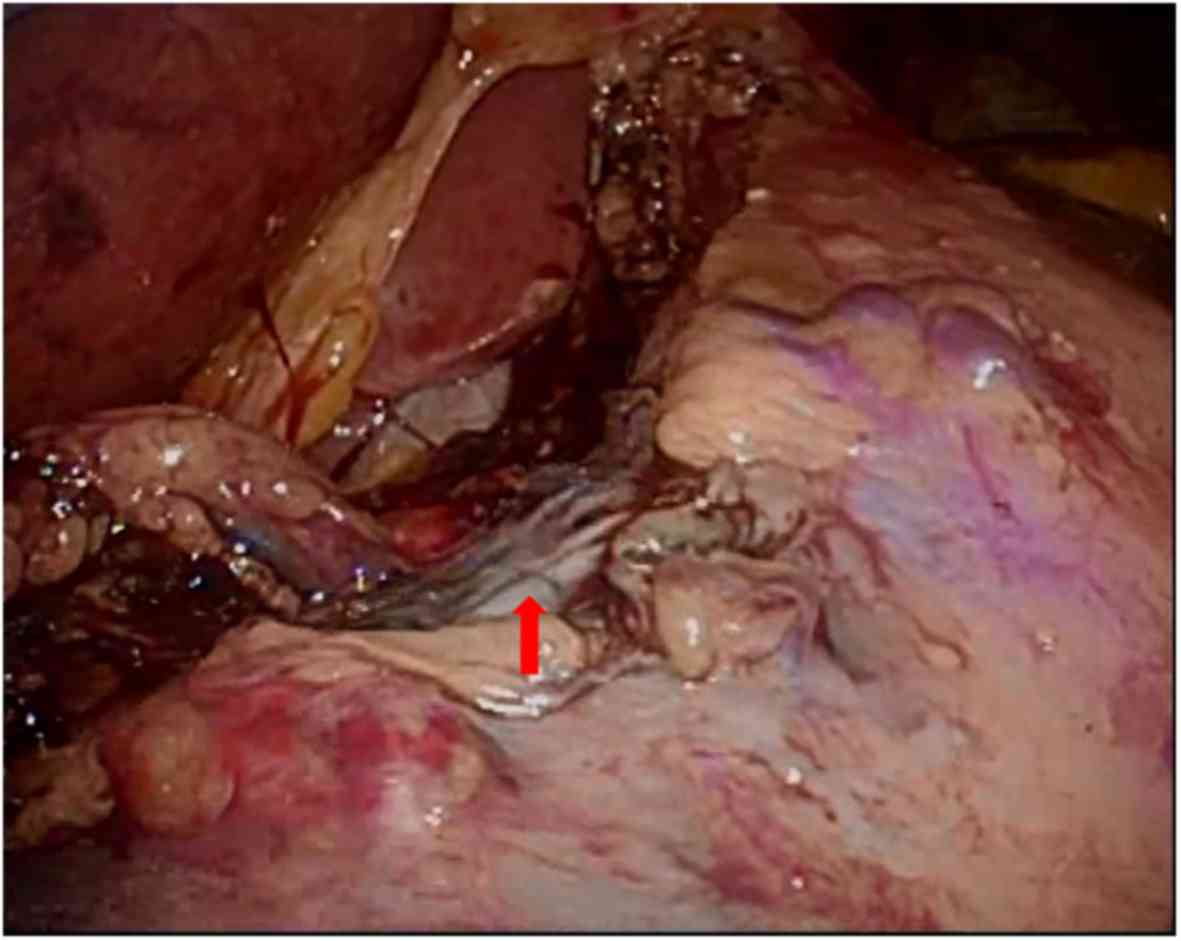 |
Figure 4
|
 |
Figure 5
|
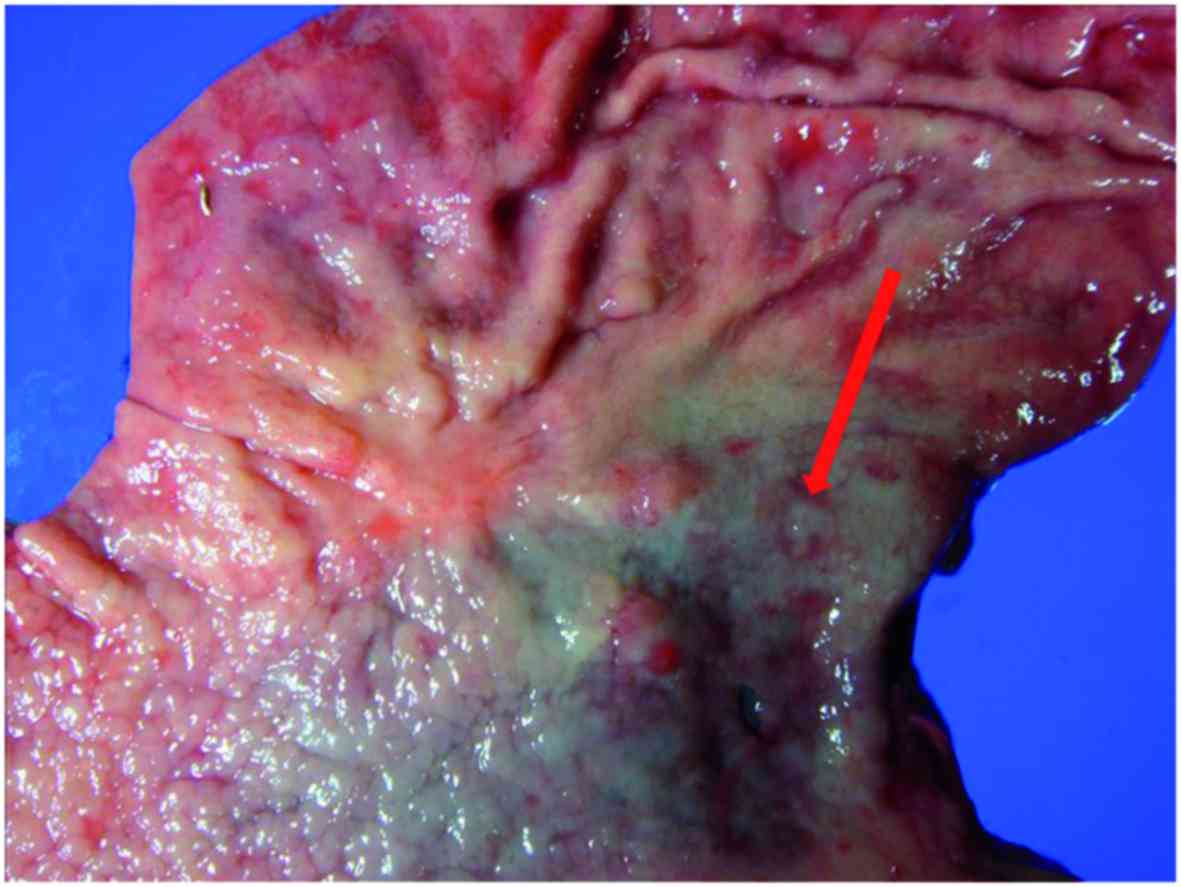 |
Figure 6
|
View References
|
1
|
Kitano S, Iso Y, Moriyama M and Sugimachi
K: Laparoscopy-assisted Billroth I gastrectomy. Surg Laparosc
Endosc. 4:146–148. 1994.PubMed/NCBI
|
|
2
|
Kanaya S, Gomi T, Momoi H, Tamaki N, Isobe
H, Katayama T, Wada Y and Ohtoshi M: Delta-shaped anastomosis in
totally laparoscopic Billroth-I gastrectomy: New technique of
intraabdominal gastroduodenostomy. J Am Coll Surg. 195:284–287.
2002. View Article : Google Scholar : PubMed/NCBI
|
|
3
|
Takaori K, Nomura E, Mabuchi H, Lee SW,
Agui T, Miyamoto Y, Iwamoto M, Watanabe H and Tanigawa N: A secure
technique of intracorporeal Roux-Y reconstruction after
laparoscopic distal gastrectomy. Am J Surg. 189:178–183. 2005.
View Article : Google Scholar : PubMed/NCBI
|
|
4
|
Lee SW, Tanigawa N, Nomura E, Tokuhara T,
Kawai M, Yokoyama K, Hiramatsu M, Okuda J and Uchiyama K: Benefits
of intracorporeal gastrointestinal anastomosis following
laparoscopic distal gastrectomy. World J Surg Oncol. 10:2672012.
View Article : Google Scholar : PubMed/NCBI
|
|
5
|
Kim HI, Hyung WJ, Lee CR, Lim JS, An JY,
Cheong JH, Choi SH and Noh SH: Intraoperative portable abdominal
radiograph for tumor localization: A simple and accurate method for
laparoscopic gastrectomy. Surg Endosc. 25:958–963. 2011. View Article : Google Scholar : PubMed/NCBI
|
|
6
|
Kinoshita T, Shibasaki H, Oshiro T,
Ooshiro M, Okazumi S and Katoh R: Comparison of
laparoscopy-assisted and total laparoscopic Billroth-I gastrectomy
for gastric cancer: A report of short term outcomes. Surg Endosc.
25:1395–1401. 2011. View Article : Google Scholar : PubMed/NCBI
|
|
7
|
Kanaya S, Kawamura Y, Kawada H, Iwasaki H,
Gomi T, Satoh S and Uyama I: The delta-shaped anastomosis in
laparoscopic distal gastrectomy: Analysis of the initial 100
consecutive procedures of intracorporeal gastroduodenostomy.
Gastric Cancer. 14:365–371. 2011. View Article : Google Scholar : PubMed/NCBI
|
|
8
|
Hyung WJ, Lim JS, Cheong JH, Kim J, Choi
SH, Song SY and Noh SH: Intraoperative tumor localization using
laparoscopic ultrasonography in laparoscopic-assisted gastrectomy.
Surg Endosc. 19:1353–1357. 2005. View Article : Google Scholar : PubMed/NCBI
|
|
9
|
Japanese Gastric Cancer Association, .
Japanese classification of gastric carcinoma: III English edition.
Gastric Cancer. 14:101–112. 2011. View Article : Google Scholar : PubMed/NCBI
|
|
10
|
Okamura R, Hamagaki M, Hayashi M, Kuwana
M, Yamamoto H, Shinofuji M, Yamamoto A, Inoue S, Satomi T, Fujita
N, et al: Preoperative endoscopic injection of carbon ink as a
method to demarcate area for gastrectomy applied to early gastric
cancers. Stomach and Intestine. 23:441–445. 1988.
|
|
11
|
Japanese Gastric Cancer Association, .
Japanese gastric cancer treatment guidelines 2010 (ver. 3). Gastric
Cancer. 14:113–123. 2011. View Article : Google Scholar : PubMed/NCBI
|















